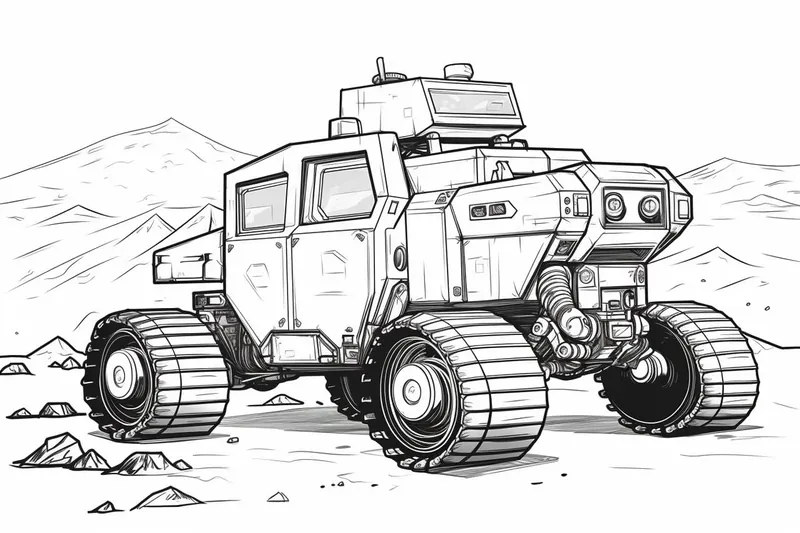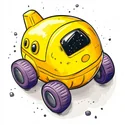How to Draw a Space Rover
Learn how to draw a Space Rover with this step-by-step tutorial! Explore techniques and tips for creating a detailed and realistic illustration of a futuristic vehicle designed for space exploration. Whether you're a beginner or experienced artist, this article will help you master the art of drawing a Space Rover.

Materials You'll Need
- Pencil
- Paper
- Eraser
 Welcome, aspiring artists! Today, we begin our journey into drawing a Space Rover—an advanced machine built to explore the rugged, unexplored terrains of other planets while capturing breathtaking imagery and gathering vital data from the cosmos.
Welcome, aspiring artists! Today, we begin our journey into drawing a Space Rover—an advanced machine built to explore the rugged, unexplored terrains of other planets while capturing breathtaking imagery and gathering vital data from the cosmos.
Together, we'll learn how to bring this futuristic vehicle to life on paper, detailing everything from its sleek metallic body to its intricate wheels and high-tech instruments. Grab your pencils and sketchpads as we ignite our creativity and embark on an artistic odyssey that blends science and art.
Materials Required
To draw a Space Rover, you will need the following materials:
- Paper: You can use sketching paper or drawing paper of your choice.
- Pencils: A set of graphite pencils in various grades (H for lighter lines, B for darker lines) for sketching and shading.
- Eraser: A soft eraser for correcting mistakes and lightening pencil marks.
- **Ruler:**To create straight lines and measure proportions accurately.
- **Sharpener:**To keep your pencils sharp for precise details.
- Reference images: Gather images of different space rovers for inspiration and reference.
- Optional: Colored pencils or markers if you want to add color to your drawing.
With these materials, you can start:
How to Draw a Space Rover: a Step-by-step Guide
Step 1: Gather Your Materials
Step 2: Start with Basic Shapes
- Begin by sketching the outline of the space rover using basic shapes such as rectangles, squares, and circles to create the body, wheels, and other features.
Step 3: Add Details to the Body
- Draw the main body of the space rover, adding details such as antennas, solar panels, sensors, and other equipment typically found on a rover.
Step 4: Draw the Wheels
- Sketch the wheels of the space rover, making sure they are proportional to the body and evenly spaced. Add treads or other details to make them look realistic.
Step 5: Add Texture and Shading
- Use hatching and cross-hatching techniques to add texture and depth to the various parts of the space rover. Shade areas that would be in shadow to create a more three-dimensional look.
Step 6: Refine and Clean Up
- Go over your drawing, refining the details and making any necessary adjustments to ensure symmetry and balance. Use an eraser to clean up any stray lines or smudges.
Step 7: Final Touches
- Add any final touches such as background elements, a surface for the rover to be driving on, or additional details to enhance the overall composition of your drawing.
Step 8: Review and Evaluate
- Step back and take a look at your drawing as a whole. Make any final adjustments or additions to ensure your space rover drawing looks complete and visually appealing.
Step 9: Sign and Date Your Work
- Once you are satisfied with your drawing, sign your name and date it to mark the completion of your artwork.
Step 10: Share and Enjoy
- Share your space rover drawing with others and take pride in your artistic creation. Consider experimenting with different styles or adding your own creative twist to future drawings.
Tip: When drawing your Space Rover, focus on breaking the vehicle down into basic geometric shapes before adding details. Start with large rectangles for the body and cylinders for the wheels to establish proportions and layout. Use a ruler to keep your lines straight, especially for the mechanical components, which often have a precise, angular look. Once you have your basic shapes, layer in the details like antennas and solar panels, using a softer pencil (like a 2B) for shading to give depth and dimension. Don't hesitate to use references of real rovers for accuracy—this will help you capture the unique features that make these vehicles so fascinating!
Conclusion
Well done on completing your drawing of the Space Rover! Your attention to detail and creativity really shine through in this artwork. Remember that every drawing, no matter how big or small, is a step towards improvement and growth as an artist. Keep exploring new techniques and subjects, and continue to push yourself creatively. Your dedication and passion for art are truly inspiring. Keep up the great work!
Fun Facts About Space Rovers
- The first successful rover mission to another planet was NASA's Mars Pathfinder mission in 1997, which included the Sojourner rover.
- The Opportunity rover operated on Mars for over 14 years, far surpassing its original 90-day mission timeline.
- The Curiosity rover, currently exploring Mars, is the largest and most advanced rover ever sent to another planet.
- The wheels of some Mars rovers, such as Curiosity, leave unique patterns in the Martian soil that can be used to track their movements.
- The Mars rovers are powered by solar panels, which need to be carefully designed to withstand the harsh conditions on the Red Planet.
- The Perseverance rover, launched in 2020, carries a small helicopter named Ingenuity, which successfully demonstrated powered flight on Mars for the first time.
- The Soviet Union's Lunokhod program deployed two robotic rovers on the Moon in the 1970s, making them the first remote-controlled rovers to explore another celestial body.
- Rovers like Spirit and Opportunity have sent back stunning photographs of the Martian landscape, helping scientists better understand the geology and history of the planet.
- NASA's upcoming Dragonfly mission will deploy a rotorcraft lander on Saturn's moon Titan to explore its diverse terrain and study its organic chemistry.
- The development and operation of space rovers involve collaboration between scientists, engineers, and mission controllers from around the world, making them truly international endeavors.
Suggestions for Scenes and Settings for Space Rover Drawings
Sure! Here are some suggestions for scenes and settings for drawings of a Space Rover:
- [A rocky and barren alien planet](https://yonderoo.com/how-to-draw-an-exoplanet/) with colorful and unusual rock formations in the background.
- A Space Rover exploring a vast crater on the surface of the moon, with Earth visible in the sky.
- A futuristic space colony with multiple Rovers working together to gather resources and conduct research.
- A Space Rover navigating through a dense asteroid field, with the sun shining brightly in the background.
- A Martian landscape with a dust storm approaching, creating a sense of tension and urgency for the Rover.
- A Space Rover parked next to a crashed spaceship, with the crew working together to repair the damage.
- A lush and exotic alien jungle, with the Rover carefully maneuvering through dense foliage and strange creatures.
- An icy moon of a gas giant, with the Rover investigating frozen geysers and ice formations.
- A Space Rover on a mission to collect samples from a comet, with the glowing tail of the comet streaking across the sky.
- A futuristic city on a distant planet, with sleek and advanced Rovers moving through bustling streets filled with alien beings.